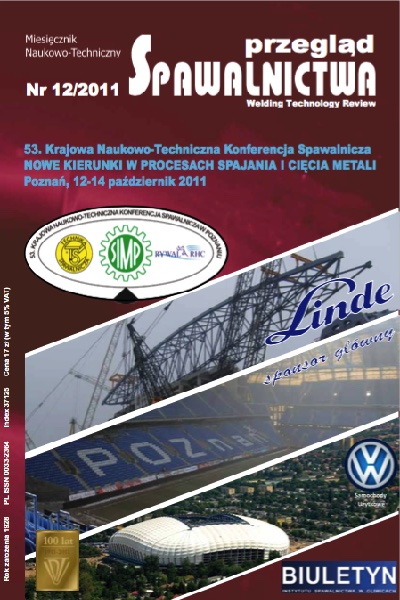Modyfikacja warstwy wierzchniej biomateriałów na przykładzie tytanu metodą stopowania plazmowego
Main Article Content
Abstract
W artykule przedstawiono wyniki modyfikacji warstwy wierzchniej tytanu metodą stopowania plazmowego powierzchni, a następnie jej trawienia elektrochemicznego. Zastosowanie prekursora nanokrystalicznego w istotny sposób wpływa na właściwości wyjściowe otrzymywanych warstw. Zastosowanie procesu mechanicznej syntezy prowadzi do zmniejszenia wielkości ziarna prekursora z jego częściową amorfizacją. Zmodyfikowaną przez proces stopowania plazmowego mikrostrukturę obserwowano przy użyciu mikroskopii optycznej. Dla zastosowanego nanoprekursora proszkowego otrzymano strukturę kompozytową warstwy składającą się z matrycy Ti (α) oraz wydzieleń fazy TiB potwierdzoną badaniami strukturalnymi XRD. Uzyskano znaczący wzrost mikrotwardości otrzymanej warstwy 900 HV w porównaniu z podłożem 160 HV. Zaprezentowano wyniki badań biokompatybilności otrzymanej warstwy na hodowli komórkowej ludzkich osteoblastów w zestawieniu z mikrokrystalicznym tytanem. Wykonano testy od- porności korozyjnej w roztworze Ringera w temperaturze 37 ÌŠC, powierzchni po modyfikacji. Z analiz wynika, iż stopowanie plazmowe jest efektywną metodą wytwarzania warstw kompozytowych typu Ti+TiB.
Biomaterials surface modification on the titanium example by microplasma alloying
Abstract
The paper presents the results of surface modification of pure titanium by boride microplasma alloying approach and following process of electrochemical treatment of obtained layer. Application of nanocrystaline precursor affects significant on properties of obtained layers. Applied mechanical alloying process of precursor powders leads to its partially amorphization and grain size decrease. Additionally, the modified microstructure was observed by optical microscopy. For used nano precursor, composite microstructure consisted from Ti (α) matrix and TiB precipitation confirmed by XRD analysis, were observed. The Vickers microhardness was significantly improve from 160 HV for original substrate to even 900 HV in obtained composite layer structure. In vitro biocompatibility test on human osteoblast cell culturefor obtained layer in com- parison with pure microcrystalline titanium results were present. The surface corrosion resistance test in ringer solution at 37 ̊C, were performed on obtained layer. Results shows that boride microplasma alloying is an effective method of composite Ti+TiB layer structure formation.
Downloads
Article Details
Creative Commons CC BY 4.0 https://creativecommons.org/licenses/by/4.0/
Welding Technology Review (WTR) articles are published open access under a CC BY licence (Creative Commons Attribution 4.0 International licence). The CC BY licence is the most open licence available and considered the industry 'gold standard' for open access; it is also preferred by many funders. This licence allows readers to copy and redistribute the material in any medium or format, and to alter, transform, or build upon the material, including for commercial use, providing the original author is credited.
References
R.R. Boyer: An overview on the use of titanium in the aerospace industry, Materials Science and Engineering A 213 (1996) 103.
K.B. Panda, K.S. Ravi Chandran: Titanium-Titanium Boride (Ti-TiB) Functionally Graded Materials through Reaction Sintering: Synthesis, Microstructure, and Properties, Metallurgical and Materials Transactions 34A (2003) 1371.
Marc Long, H.J. Rack: Titanium alloys in total joint replacement a materials science perspective. Biomaterials 19 (1998) 1621.
K.B. Panda, K.S. Ravi Chandran: Synthesis of Ductile TitaniumTitanium Boride (Ti-TiB) Composites with a Beta-Ti- tanium Matrix: The Nature of TiB Formation and Composi- te Properties, Metallurgical and Materials Transactions 34A (2003) 1993.
R. Gadow, A. Killinger, N. Stiegler : Hydroxyapatite coatings for biomedical applications deposited by different thermal spray techniques, Surface & Coatings Technology 205 (2010) 1157.
Giovanni Bolelli, Valeria Cannillo, Rainer Gadow, Andreas Killinger, Luca Lusvarghi, Antonella Sola, Nico Stiegler Microstructure and in-vitro behaviour of a novel High Velocity Suspension Flame Sprayed (HVSFS) bioactive glass coating, Surface & Coatings Technology 205 (2010) 1145
Guocheng Wang, Fanhao Meng, Chuanxian Ding, Paul K. Chu, Xuanyong Liu, Microstructure, bioactivity and osteoblast behavior of monoclinic zirconia coating with nano- structured surface. Acta Biomaterialia 6 (2010) 990.
Guocheng Wang, Fanhao Meng, Chuanxian Ding, Paul K. Chu, Xuanyong Liu: Microstructure, bioactivity and osteoblast behavior of monoclinic zirconia coating with nano- structured surface, Acta Biomaterialia 6 (2010) 990.
Xuanyong Liu, Ray W.Y. Poon, Sunny C.H. Kwok, Paul K. Chu, Chuanxian Ding: Plasma surface modification of titanium for hard tissue replacements, Surface & Coatings Technology 186 (2004) 227.
Manoj Masanta, P. Ganesh, Rakesh Kaul, A.K. Nath, A. Roy Choudhury: Development of a hard nano-structured multi-component ceramic coating by laser cladding, Materials Science and Engineering A 508 (2009) 134.
Yuling Yang, Duo Zhang, Wei Yan, Yiran Zheng: Microstructure and wear properties of TiCN/Ti coatings on titanium alloy by laser cladding, Optics and Lasers in Engineering 48 (2010) 119.
M. Alhammad, S. Esmaeili, E. Toyserkani: Surface modification of Ti6Al4V alloy using laser-assisted deposition of a TiSi compound, Surface & Coatings Technology 203 (2008) 1.
A. Miklaszewski, M.U. Jurczyk, K. Jurczyk, M. Jurczyk: Plasma surface modification of titanium by TiB precipitation for biomedical applications, Surface and Coatings Technology (SCT_16891) accepted
